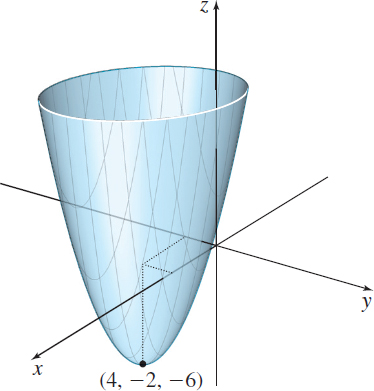EXAMPLE 3Using the Second Partial Derivative Test
Find all local maxima, local minima, and saddle points for z=f(x,y)=x2+xy+y2−6x+6
Solution The critical points of f are solutions of the system of equations {fx(x,y)=2x+y−6=0fy(x,y)=x+2y=0

Figure 16 z=f(x,y)=x2+xy+y2−6x+6
The only solution is x=4 and y=−2, so (4,−2) is the only critical point.
The second-order partial derivatives of f are fxx(x,y)=2fxy(x,y)=fyx(x,y)=1fyy(x,y)=2
The function f meets the requirements of the Second Partial Derivative test at the critical point (4,−2). Now A=fxx(4,−2)=2B=fxy(4,−2)=1C=fyy(4,−2)=2 AC−B2=(2)(2)−12=3>0
Since AC−B2>0 and A=fxx(4,−2)=2>0, the Second Partial Derivative Test guarantees that f has a local minimum at (4,−2). The local minimum value is z=f(4,−2)=−6. See Figure 16.